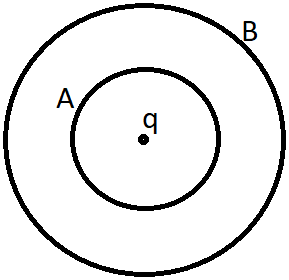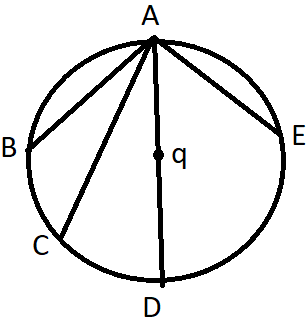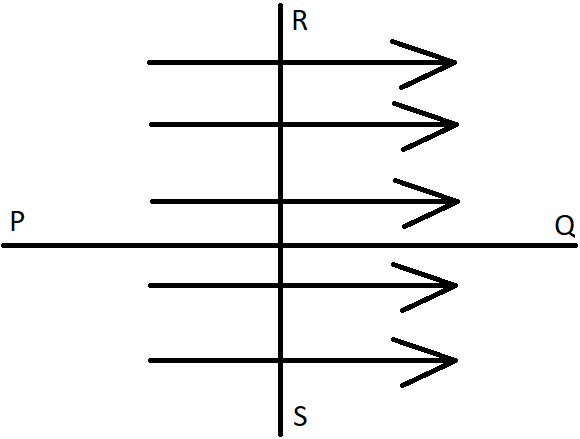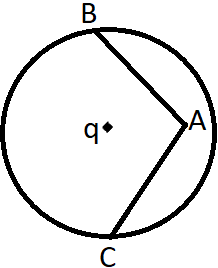This set of Class 12 Physics Chapter 2 Multiple Choice Questions & Answers (MCQs) focuses on “Equipotential Surfaces”.
1. What is the nature of equipotential surfaces in case of a positive point charge?
a) Circular
b) Spherical
c) Cubical
d) Cylindrical
View Answer
Explanation: We know that electric field lines cross the equipotential surfaces perpendicularly. Electric field lines are generated radially from a positive point charge. Therefore, for holding both the conditions, the equipotential surfaces must be spherical.
2. What will be the nature of equipotential surfaces due to a point charge, situated at infinity?
a) Plane surface
b) Spherical
c) Elliptical
d) Cylindrical
View Answer
Explanation: If a point charge is situated at infinity, the electric field lines coming out of it will be in the form of parallel straight lines. As we know that field lines cut the equipotential surfaces orthogonally, therefore the equipotential surfaces must be plane surfaces. They can be considered the surface of a sphere of infinite radius.
3. An electric field is directed along the tangent of an equipotential surface.
a) True
b) False
View Answer
Explanation: Electric field lines cut the equipotential surfaces at an angle of 90 degrees. The direction of the electric field is the same as the direction of electric field lines. Therefore, the field is perpendicular to the equipotential points, not tangent to them.
4. Which of the following statements is correct?
a) An electric field is a scalar quantity
b) Electric field lines are at 45 degrees to the equipotential surfaces
c) The surface of a charged conductor is equipotential
d) Field lines due to a point charge are circular
View Answer
Explanation: In conductors, charges are equally distributed over the surface of the conductor. Therefore the potential throughout the surface is the same, i.e. equipotential. The electric field is a vector quantity and the field lines cut the equipotential surfaces at 90 degrees. The field lines due to a point charge are radial.
5. A charge q is placed on an equipotential surface and electric field intensity at that place is E. What is the work done to move the charge by a distance x on the surface?
a) x*\(\frac {q}{E}\)
b) x*q*E
c) E*\(\frac {x}{q}\)
d) Zero
View Answer
Explanation: As the surface is equipotential, all the points on the surface of the plane have the same potential values. Therefore work done to move the charge by a distance x on that surface is zero. The electric field plays no role here.
6. If A and B are two equipotential surfaces around a positive point charge q, what will happen if we place another point charge +Q between A and B?

a) It will remain stationary
b) It will move from B to A
c) It will move from A to B
d) It will rotate in a circular path
View Answer
Explanation: A charge always tries to move from a point of higher potential to a point of lower potential. The potential at A is greater than the potential at B because of electric potential decreases with distance from the charge. It can also be explained by the fact that a positive charge is always repelled by another positive charge.
7. A charge q is at the center of the circle ABCDE. Which among the following is true if the charge is taken from A to B, C, D, and E?

a) Work done along AB is the minimum
b) Work done along AD is the maximum
c) Work done along all the paths are zero
d) Work done along all the paths are equal but positive
View Answer
Explanation: As the charge q is situated at the center of the circle ABCDE, therefore the circle is an equipotential surface. That means all the points on the circle i.e. A, B, C, D, and E have the same potential. Therefore, work done to bring the charge from A to any point on the circle is zero always.
8. A smaller sphere has potential 50V and a larger sphere has potential 100V. How should they be placed so that if they are connected with the help of a wire, the charge will flow from the smaller sphere to the larger sphere? Both the spheres are conducting and hollow.
a) Concentrically
b) Touching each other
c) It is never possible
d) The smaller sphere should be grounded
View Answer
Explanation: We know that for a conducting sphere, the charge is always distributed on its outer surface. We also know that charge flows from higher potential to lower potential. But if we put the smaller sphere inside the larger sphere and connect them with a conductor, they will act as a single conductor and charge will be distributed to its outer surface, i.e. charge will flow to the larger sphere.
9. According to the diagram, the equipotential points are _____. The arrows are the direction of the electric field.

a) P and Q
b) S and Q
c) S and R
d) P and R
View Answer
Explanation: The equipotential surface is always perpendicular to the electric field lines. In the diagram, the electric field lines are horizontal and parallel to each other. Therefore, the equipotential lines must be vertical and the points that have equal potential should be on the vertical line. Therefore, R and S have equal potential.
10. A charge q is placed at the center of a circle and B, C are the points on the circle. Another charge q is moved from A to B and from A to C. Which of them is correct?

a) Work along AC path is more
b) Work done in both cases are the same
c) Work done along AB path is more
d) Work done in both the cases are zero
View Answer
Explanation: B and C points are situated on the circle, so they are on the equipotential surface. To bring a point charge from A to B and from A to C requires the same amount of work done as the initial and final points have the same potential energy in both the cases. Work done to bring a charge from B to C is zero.
Sanfoundry Global Education & Learning Series – Physics – Class 12.
To practice all chapters and topics of class 12 Physics, here is complete set of 1000+ Multiple Choice Questions and Answers.
If you find a mistake in question / option / answer, kindly take a screenshot and email to [email protected]
- Practice Class 12 - Chemistry MCQs
- Check Class 12 - Physics Books
- Practice Class 12 - Mathematics MCQs
- Practice Class 11 - Physics MCQs
- Practice Class 12 - Biology MCQs
